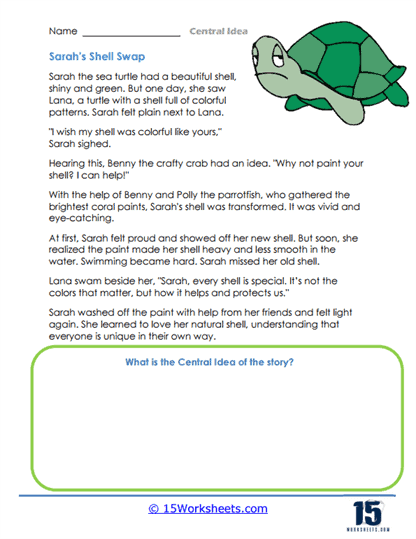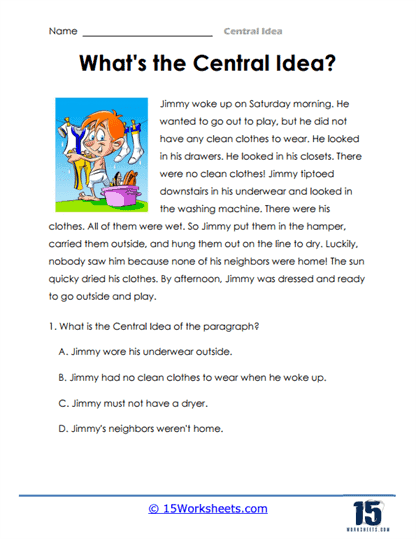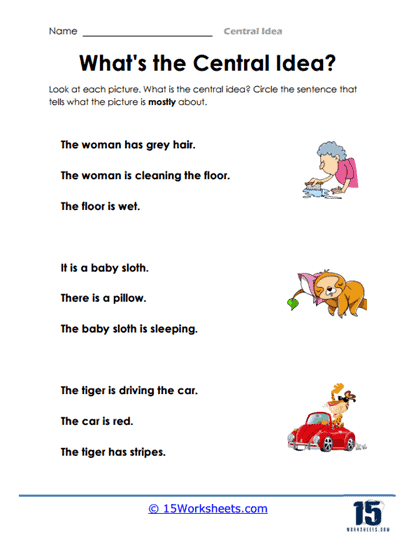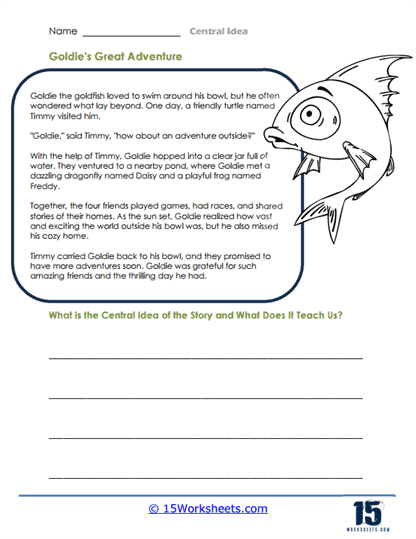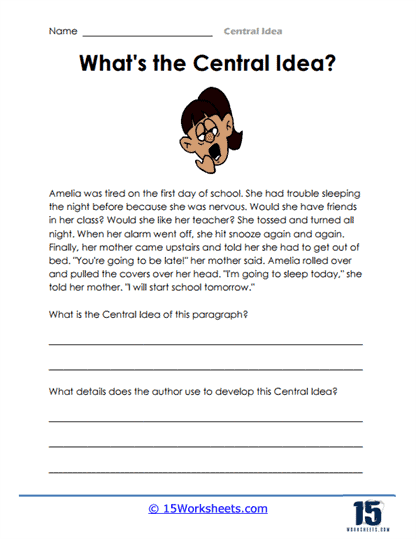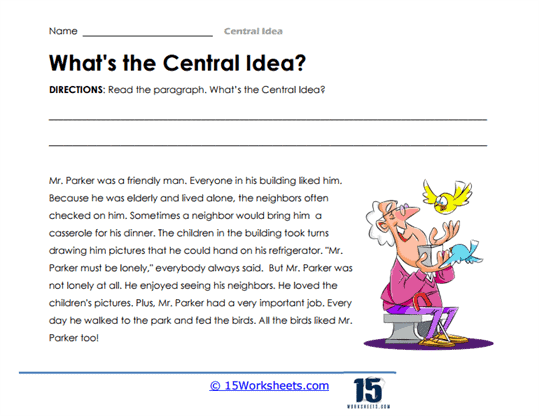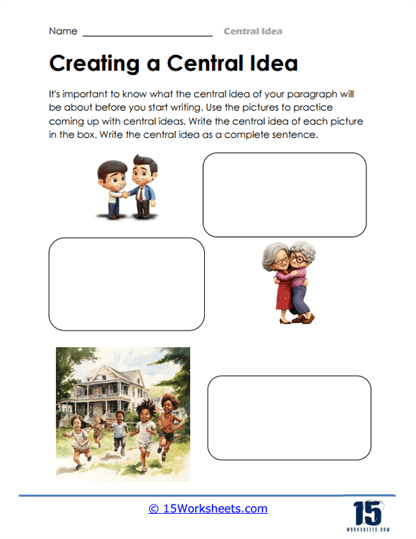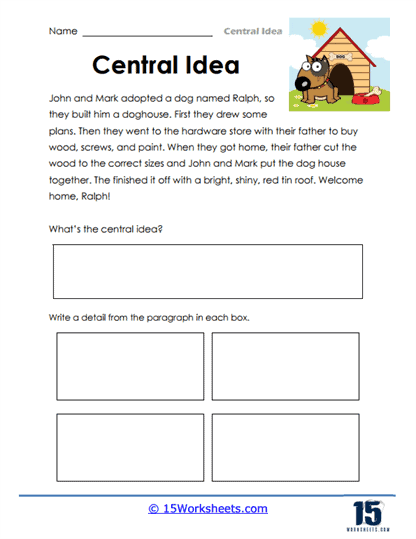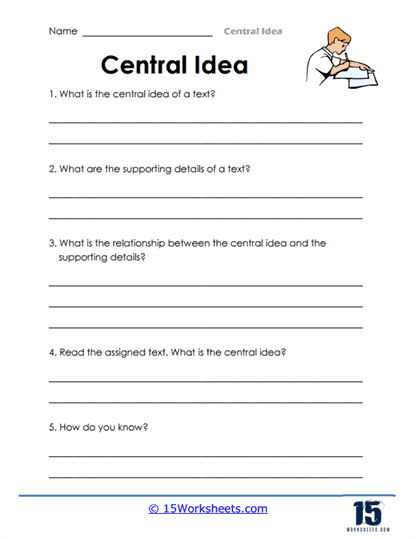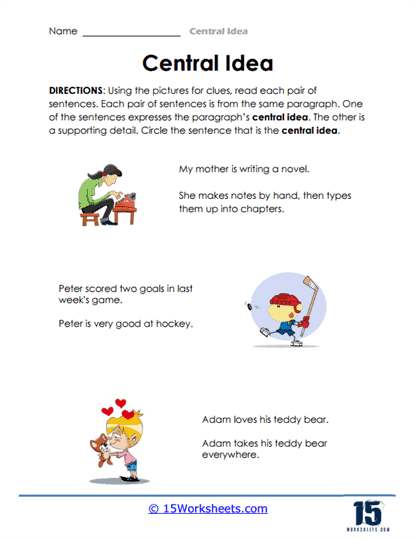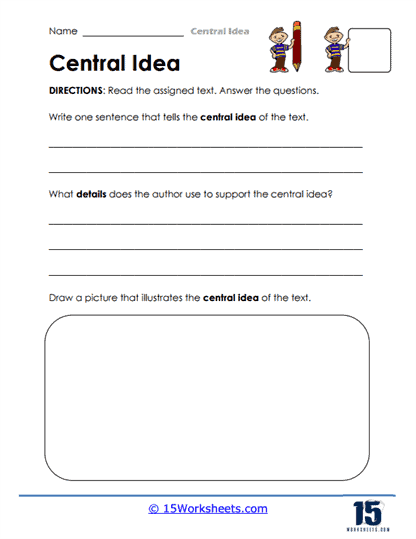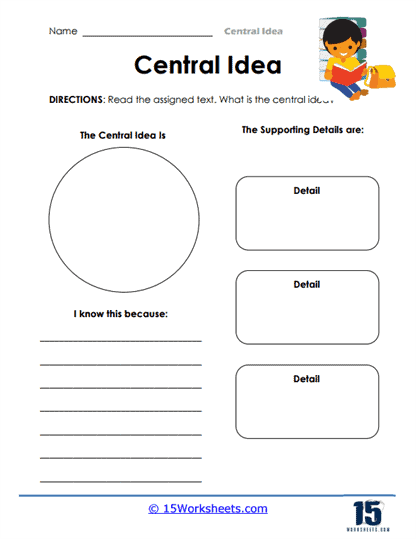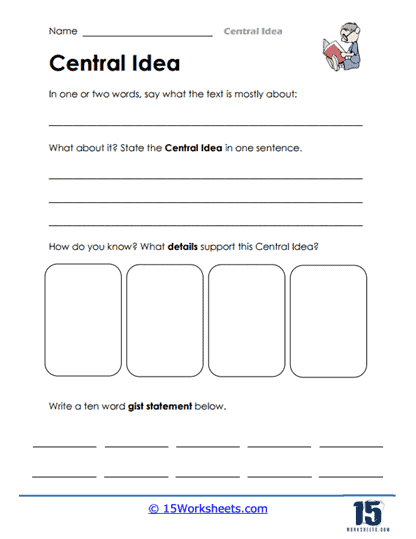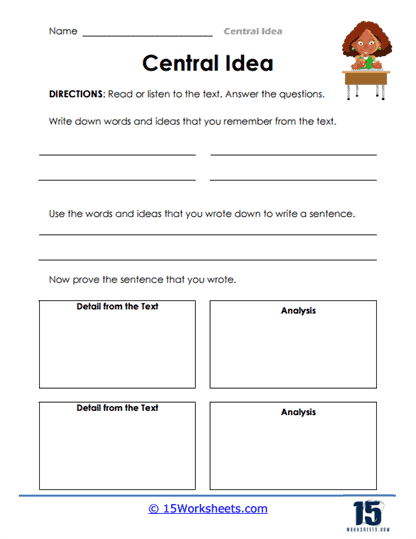Central Ideas Worksheets
All About These Worksheets
Imagine you’re watching a thrilling superhero movie. The hero, once unsure of their abilities, embarks on a journey of discovery, learning how to use their powers for good. As the story unfolds, one central theme becomes crystal clear: “With great power comes great responsibility.” This isn’t just a catchy line; it’s the heart of the narrative, the idea the writer wants to leave with the audience. By the time the credits roll, you’re not only entertained but also reflecting on the importance of responsibility in your own life. This is the power of a central idea-it’s the core message that lingers long after the details fade.
When you’re reading a story, an article, or even a single paragraph, finding the central idea is a bit like playing detective. You gather clues, piece together evidence, and ultimately uncover the main point that the writer wants you to grasp. But you don’t need a magnifying glass or a trench coat for this kind of investigation-worksheets designed to identify central ideas serve as your detective tools. They help guide you through the process, offering exercises and problems that sharpen your skills in finding the heart of the text.
These worksheets are more than just academic exercises; they are gateways to deeper comprehension. They often provide a passage-be it a short article, a paragraph, or even a narrative-followed by questions that prompt the reader to think critically. What is the writer really trying to say? What message lies beneath the surface details? This kind of practice is essential because the central idea is the anchor of any well-written piece. It shapes the entire text and gives meaning to the supporting details. Without it, the words would be scattered, lacking direction and impact.
For students, mastering the ability to identify the central idea isn’t just about acing a test. It’s a vital skill that applies to all forms of communication, from reading news articles to understanding complex concepts in academic texts. It’s about learning to sift through information, distill what’s most important, and see the bigger picture. In today’s world, where we are bombarded with endless streams of content, this skill has never been more crucial. Knowing how to pinpoint the central idea helps cut through the noise and focus on what truly matters.
Types of Exercises
In Les and the Wobbly Tower, kids find themselves teetering on the edge of disaster while pinpointing the main point (hint: it’s not just about bad construction). Sarah’s Shell Swap and Goldie’s Great Adventure send young readers on seaside and woodland quests where they must separate shiny plot details from the solid nugget of the story’s central message-think hermit crabs with identity issues and daring fish with personal growth arcs.
The collection doesn’t stop with wacky narratives-oh no! Worksheets like Visual Insight Quest, Picturing Core Concepts, and Write and Draw ask students to don their detective monocles and infer central ideas from pictures. Yes, pictures. Because nothing says “aha moment” like figuring out the big idea behind a confused cartoon squirrel trying to organize his acorn stash. And then there’s Sentence Sleuths, which sounds like a new streaming crime drama, but is actually a chance for kids to extract meaning from tangled webs of sentences. For those students who really love a challenge (or for teachers who really need five minutes of peace), there’s The Gist of It, Recall, State, Support, and Uncovering the Key Message-worksheets that take summarizing and central idea hunting to near-ninja level.
But don’t worry-it’s not all high-stakes acorn analysis. Worksheets like Amelia’s First Day, Jimmy’s Laundry Day, and The Friendly Mr. Parker bring heartwarming narratives with deceptively simple central ideas (spoiler: making friends and doing laundry are harder than they look). Welcome Home, Ralph! gives us an emotional homecoming, while Author’s Purpose and Beyond spirals into an existential quest to discover not just what the author wrote, but why they even bothered. Finally, Writing Tune-Up and Piece It Together ensure your students not only recognize central ideas, but also create them-making them central-idea ninjas and authors in training. It’s literary comprehension wrapped in fun, stuffed with plot, and sprinkled with just enough absurdity to keep everyone (including you) entertained.
This section introduces different types of exercises that will help you identify the main message in a story using a variety of activities. Here is breakdown of the fundamental type of work you will find above.
Multiple Choice Questions – These are like mini quizzes. After reading a short story or paragraph, there will be questions with a few answer choices. You need to circle or tick the correct answer. For example:
Story – Jenny saves her money every month. She wants to buy a bicycle. After one year, she has enough to buy the bicycle she wanted.
Question – What is the central idea of the story?
a) Jenny loves ice cream.
b) Jenny saves money for a bicycle.
c) Jenny has a pet cat.
The correct answer is b) Jenny saves money for a bicycle.
Matching – Here, you’ll see a list of stories on one side and a list of central ideas on the other. You have to draw lines connecting each story to its central idea. It’s like connecting the dots.
Short Answer Questions – Instead of multiple choices or lines to match, you write a sentence or two to explain the main message of a story or paragraph. This helps you express the central idea in your own words.
Highlighting or Underlining – These exercises are like coloring but with a purpose. You’ll be asked to read a paragraph and highlight or underline sentences that give clues about the central idea. It’s a fun way to spot important details.
Story Pyramid – This exercise helps you break down a story step by step. At the base of the pyramid, you might write the main characters. As you go up, you add important events. At the top, you write the central idea. It’s like building a story from the ground up!
Discussion Circles – Sometimes, talking helps. You and your friends read a story together and discuss what you think the central idea is. By listening to each other, you can get a clearer picture.
Central ideas worksheets serve as valuable tools for assessing and improving students’ reading comprehension skills, analytical thinking, and ability to extract essential information from written material.
By engaging with these worksheets, students can become more proficient at understanding the core concepts and themes of various types of texts, which is a crucial skill for academic success and real-world applications.
How to Determine the Central idea From What You Read
Reading a story or an article is like embarking on an exciting treasure hunt, where instead of jewels or gold, you’re seeking something even more valuable – knowledge. The treasure you’re hunting for is called the “central idea.” This is the core message or main point that the author wants to convey. But how do you go about finding this elusive treasure hidden within the pages? Let’s break it down step by step and explore the process of uncovering the central idea, ensuring that you’ll leave no stone unturned.
Step 1 – Dive Into the Text With Purpose
The first step in determining the central idea is to approach your reading with an open mind and a sense of curiosity. Much like a treasure hunter carefully examines a map, you should read through the text with the intention of finding patterns, clues, and key themes. Don’t rush—take your time to absorb what the author is trying to say.
As you read, pay attention to the overall theme of the story or article. Ask yourself, “What is this mostly about?” or “What message keeps showing up in different parts of the text?” If you’re reading a story about whales, for example, and the writer constantly emphasizes their size, their habitat in the ocean, and their unique characteristics, then it’s likely that the central idea revolves around the significance of whales as large, fascinating creatures of the sea. Remember, the central idea isn’t always spelled out for you; sometimes it’s hidden between the lines, waiting for you to discover it.
Step 2 – Look for Repeated Concepts or Themes
One of the biggest clues to uncovering the central idea is repetition. Writers often reinforce their main point by revisiting certain ideas, phrases, or themes throughout the text. These repetitions act as a beacon, guiding you toward the core message. For instance, if a writer frequently mentions the importance of protecting the environment in an article about climate change, it’s a good indication that the central idea is about environmental conservation.
Take note of what ideas keep coming up. Does the author repeatedly emphasize a particular problem, solution, or concept? When you identify these recurring ideas, you’re likely closing in on the central message.
Step 3 – Pay Attention to the Beginning and the End
Authors often provide strong hints about the central idea in the introduction or conclusion of their work. The opening of an article or story sets the stage for what’s to come, often introducing the main topic or question that will be explored. Similarly, the conclusion usually ties everything together, summarizing the key points the author wants you to walk away with. If you’re unsure about the central idea after reading the whole piece, it’s worth revisiting these two critical parts.
Think of the introduction and conclusion as the outer edges of a puzzle. They give you the framework to fill in the rest. By focusing on these sections, you’ll often find that the main idea becomes clearer.
Step 4 – Don’t Hesitate to Reread for Clarity
Sometimes, the central idea won’t jump out at you on your first read. That’s perfectly normal! Just like treasure hunting can require multiple attempts before striking gold, understanding the main point of a text might take a couple of reads. If you find yourself unsure, give the text another read. With each pass, new details and patterns might emerge, and the author’s message may come into sharper focus.
Rereading also gives you a chance to notice any subtle hints or themes you might have missed the first time. Often, it’s these smaller details that lead to big discoveries about the central idea.
Step 5 – Discuss the Text with Others
Another powerful strategy in your quest to find the central idea is to talk about what you’ve read with others. Whether it’s with friends, family, or classmates, discussing a story or article can offer fresh perspectives. Others might pick up on ideas or themes that you didn’t notice, helping you piece together the full picture.
Conversation opens up new avenues of thinking. When you hear how someone else interprets a text, it challenges your own perspective and might reveal aspects of the central idea that were previously hidden. Collaborative discussion can transform reading into a richer, more interactive experience, much like solving a treasure hunt with a team.
Step 6 – Practice Makes Perfect
Just as seasoned treasure hunters get better with every adventure, you too will become more skilled at identifying central ideas the more you practice. The key is to read widely and often. Every story, article, or book you encounter offers an opportunity to refine your ability to pick out the central idea.
With time, you’ll find that recognizing the core message of a text becomes second nature. What may have once felt like a challenging hunt will soon become an exciting and rewarding part of your reading journey.
Step 7 – Trust Yourself
Finding the central idea doesn’t have to be daunting. Trust your instincts and remember that reading is meant to be enjoyable. Approach each story or article as a new adventure, a chance to uncover something meaningful. Every text has its own unique treasure, and with these strategies, you’ll be well-equipped to find it.


